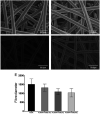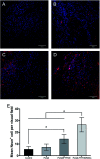Local delivery of FTY720 and NSCs on electrospun PLGA scaffolds improves functional recovery after spinal cord injury
- PMID: 35520542
- PMCID: PMC9064641
- DOI: 10.1039/c9ra01717h
Local delivery of FTY720 and NSCs on electrospun PLGA scaffolds improves functional recovery after spinal cord injury
Abstract
Spinal cord injury (SCI) is a common issue in the clinic that causes severe motor and sensory dysfunction below the lesion level. FTY720, also known as fingolimod, has recently been reported to exert a positive effect on the recovery from a spinal cord injury. Through local delivery to the lesion site, FTY720 effectively integrates with biomaterials, and the systemic adverse effects are alleviated. However, the effects of the proper mass ratio of FTY720 in biomaterials on neural stem cell (NSC) proliferation and differentiation, as well as functional recovery after SCI, have not been thoroughly investigated. In our study, we fabricated electrospun poly (lactide-co-glycolide) (PLGA)/FTY720 scaffolds at different mass ratios (0.1%, 1%, and 10%) and characterized these scaffolds. The effects of electrospun PLGA/FTY720 scaffolds on NSC proliferation and differentiation were measured. Then, a rat model of spinal transection was established to investigate the effects of PLGA/FTY720 scaffolds loaded with NSCs. Notably, 1% PLGA/FTY720 scaffolds exerted the best effects on the proliferation and differentiation of NSCs and 10% PLGA/FTY720 was cytotoxic to NSCs. Based on the Basso, Beattie, and Bresnahan (BBB) score, HE staining and immunofluorescence staining, the PLGA/FTY720 scaffold loaded with NSCs effectively promoted the recovery of spinal cord function. Thus, FTY720 properly integrated with electrospun PLGA scaffolds, and electrospun PLGA/FTY720 scaffolds loaded with NSCs may have potential applications for SCI as a nerve implant.
This journal is © The Royal Society of Chemistry.
Conflict of interest statement
The authors have no conflicts of interest to declare.
Figures








Similar articles
-
Tissue-engineered regeneration of completely transected spinal cord using induced neural stem cells and gelatin-electrospun poly (lactide-co-glycolide)/polyethylene glycol scaffolds.PLoS One. 2015 Mar 24;10(3):e0117709. doi: 10.1371/journal.pone.0117709. eCollection 2015. PLoS One. 2015. PMID: 25803031 Free PMC article.
-
Co-transplantation of neural stem cells and Schwann cells within poly (L-lactic-co-glycolic acid) scaffolds facilitates axonal regeneration in hemisected rat spinal cord.Chin Med J (Engl). 2013 Mar;126(5):909-17. Chin Med J (Engl). 2013. PMID: 23489801
-
Mash-1 modified neural stem cells transplantation promotes neural stem cells differentiation into neurons to further improve locomotor functional recovery in spinal cord injury rats.Gene. 2021 May 20;781:145528. doi: 10.1016/j.gene.2021.145528. Epub 2021 Feb 22. Gene. 2021. PMID: 33631250
-
The neuronal differentiation microenvironment is essential for spinal cord injury repair.Organogenesis. 2017 Jul 3;13(3):63-70. doi: 10.1080/15476278.2017.1329789. Epub 2017 Jun 9. Organogenesis. 2017. PMID: 28598297 Free PMC article. Review.
-
Bridging the gap with functional collagen scaffolds: tuning endogenous neural stem cells for severe spinal cord injury repair.Biomater Sci. 2018 Jan 30;6(2):265-271. doi: 10.1039/c7bm00974g. Biomater Sci. 2018. PMID: 29265131 Review.
Cited by
-
Effects of FTY720 on Neural Cell Behavior in Two and Three-Dimensional Culture and in Compression Spinal Cord Injury.Cell Mol Bioeng. 2022 Apr 8;15(4):331-340. doi: 10.1007/s12195-022-00724-0. eCollection 2022 Aug. Cell Mol Bioeng. 2022. PMID: 36119134 Free PMC article.
-
Novel Strategies for Spinal Cord Regeneration.Int J Mol Sci. 2022 Apr 20;23(9):4552. doi: 10.3390/ijms23094552. Int J Mol Sci. 2022. PMID: 35562941 Free PMC article. Review.
-
Importance of brain alterations in spinal cord injury.Sci Prog. 2021 Jul-Sep;104(3):368504211031117. doi: 10.1177/00368504211031117. Sci Prog. 2021. PMID: 34242109 Free PMC article. Review.
-
Aligned Fingolimod-Releasing Electrospun Fibers Increase Dorsal Root Ganglia Neurite Extension and Decrease Schwann Cell Expression of Promyelinating Factors.Front Bioeng Biotechnol. 2020 Aug 14;8:937. doi: 10.3389/fbioe.2020.00937. eCollection 2020. Front Bioeng Biotechnol. 2020. PMID: 32923432 Free PMC article.
-
Combined application of neural stem/progenitor cells and scaffolds on locomotion recovery following spinal cord injury in rodents: a systematic review and meta-analysis.Neurosurg Rev. 2022 Dec;45(6):3469-3488. doi: 10.1007/s10143-022-01859-4. Epub 2022 Sep 17. Neurosurg Rev. 2022. PMID: 36114918
References
LinkOut - more resources
Full Text Sources

